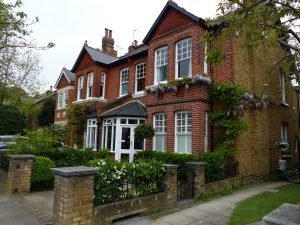1920s
At the end of the first world war, Britain was a nation in which almost 80% of people rented their homes, almost all from private landlords. Concern about the poor standards of the housing stock led the prime minister, David Lloyd George, to promise a “land fit for heroes” for the homecoming Tommies. The 1919 Housing Act provided subsidies for local authorities to build council houses.
1930s
House building peaked at 350,000 a year in the mid-1930s as a prolonged period of cheap money prompted a private-sector building boom. With land and labour plentiful, and official interest rates pegged at 2%, this was the era of the three-bedroom semi and the expansion of cities out into the suburbs. New industries – car plants, aerospace companies, engineering firms – accompanied the ribbon development along the major arterial roads.
1940s
The second world war caused a double whammy: German bombing inflicted widespread damage to urban areas while house building came to a halt. The Beveridge report identified “squalor” as one of the five “giants” blocking the road to progress, but with money tight and construction materials in short supply, the pick-up in activity was slow. Aneurin Bevan, jointly health and housing minister, insisted council homes be built to high standards.
1950s
Council-house building peaked under the Conservative government of the 1950s, when the end of rationing and a growing economy meant that 250,000 new local authority homes a year were being put up. Much of the expansion was in the new towns designated by the Attlee government in land beyond the newly created green belt surrounding London – towns such as Hemel Hempstead, Harlow and Crawley.
1960s
House price boom-busts were still a thing of the future in the 1960s, the decade that saw combined private and council house building hit a postwar peak of just over 400,000 a year. This was the era of the tower block, with quantity coming at the expense of quality. One block, Ronan Point in east London, collapsed in 1968 following a gas explosion. By the end of the 1960s, Britain had as many owner-occupiers as renters.
1970s
Britain had its first experience of a housing bubble during the so-called Barber boom of 1973. An easing of credit conditions by the Bank of England coupled with the go-for-growth strategy of the Conservative chancellor, Tony Barber, resulted in house-price inflation peaking at 36%. The average price of a home, which had risen from £2,000 to £5,000 between 1950 and 1970, doubled in the next three years. The boom ended when the Yom Kippur war and the Opec oil embargo ushered in the stagflation of the mid-1970s.
1980s
Offering council tenants the right to buy their own homes was suggested to Jim Callaghan at the end of the 1970s. He rejected the idea but it was pounced upon by Margaret Thatcher, who made it the centrepiece of her political pitch to the aspirational working classes. Those who took advantage of the offer quickly saw the value of their assets surge in Britain’s second big housing bubble – the Lawson boom. House prices rose by 16% in 1987 and a further 25% in 1988.
1990s
The bust that followed the Lawson boom was long and painful. Interest rates were raised to 15% and left there for a year to control inflation. Unemployment doubled to hit 3 million for the second time in a decade and many of those who had taken out big mortgages could no longer afford the repayments. Record numbers of people had their homes repossessed as house prices fell for four successive years. It was not until the end of the 1990s that the market started to recover.
2000s
A rising population. More than a decade and a half of steady economic growth. Ample supplies of cheap credit. A sharp fall in the number of homes being built. These were the ingredients that contributed to Britain’s third big housing bubble of the post-war period. The average house price more than doubled from £100,000 in 2000 to just under £225,000 in 2007, before the financial crash brought the boom to an end. House building fell during the recession to its lowest peacetime level since the early 1930s.
 Anybody in contact with the real estate market in the UK might have noticed until now that the housing crisis. The main issue is the huge gap between supply and demand, but specialists argue that there is more than meets the eye.
Anybody in contact with the real estate market in the UK might have noticed until now that the housing crisis. The main issue is the huge gap between supply and demand, but specialists argue that there is more than meets the eye.